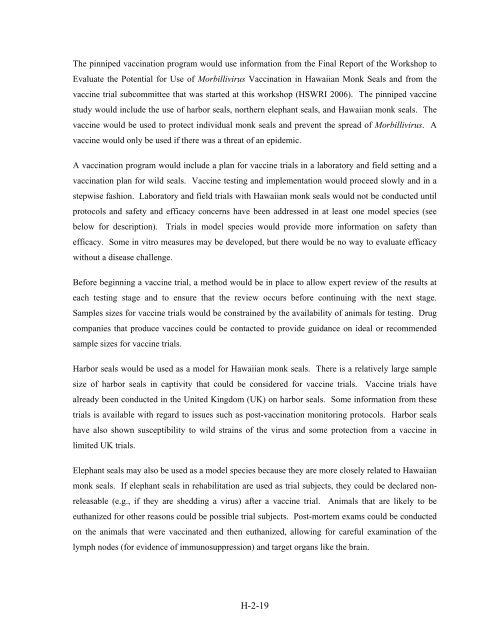Volume III, Appendices EM - National Marine Fisheries Service ...
Volume III, Appendices EM - National Marine Fisheries Service ...
Volume III, Appendices EM - National Marine Fisheries Service ...
You also want an ePaper? Increase the reach of your titles
YUMPU automatically turns print PDFs into web optimized ePapers that Google loves.
The pinniped vaccination program would use information from the Final Report of the Workshop to<br />
Evaluate the Potential for Use of Morbillivirus Vaccination in Hawaiian Monk Seals and from the<br />
vaccine trial subcommittee that was started at this workshop (HSWRI 2006). The pinniped vaccine<br />
study would include the use of harbor seals, northern elephant seals, and Hawaiian monk seals. The<br />
vaccine would be used to protect individual monk seals and prevent the spread of Morbillivirus. A<br />
vaccine would only be used if there was a threat of an epidemic.<br />
A vaccination program would include a plan for vaccine trials in a laboratory and field setting and a<br />
vaccination plan for wild seals. Vaccine testing and implementation would proceed slowly and in a<br />
stepwise fashion. Laboratory and field trials with Hawaiian monk seals would not be conducted until<br />
protocols and safety and efficacy concerns have been addressed in at least one model species (see<br />
below for description). Trials in model species would provide more information on safety than<br />
efficacy. Some in vitro measures may be developed, but there would be no way to evaluate efficacy<br />
without a disease challenge.<br />
Before beginning a vaccine trial, a method would be in place to allow expert review of the results at<br />
each testing stage and to ensure that the review occurs before continuing with the next stage.<br />
Samples sizes for vaccine trials would be constrained by the availability of animals for testing. Drug<br />
companies that produce vaccines could be contacted to provide guidance on ideal or recommended<br />
sample sizes for vaccine trials.<br />
Harbor seals would be used as a model for Hawaiian monk seals. There is a relatively large sample<br />
size of harbor seals in captivity that could be considered for vaccine trials. Vaccine trials have<br />
already been conducted in the United Kingdom (UK) on harbor seals. Some information from these<br />
trials is available with regard to issues such as post-vaccination monitoring protocols. Harbor seals<br />
have also shown susceptibility to wild strains of the virus and some protection from a vaccine in<br />
limited UK trials.<br />
Elephant seals may also be used as a model species because they are more closely related to Hawaiian<br />
monk seals. If elephant seals in rehabilitation are used as trial subjects, they could be declared nonreleasable<br />
(e.g., if they are shedding a virus) after a vaccine trial. Animals that are likely to be<br />
euthanized for other reasons could be possible trial subjects. Post-mortem exams could be conducted<br />
on the animals that were vaccinated and then euthanized, allowing for careful examination of the<br />
lymph nodes (for evidence of immunosuppression) and target organs like the brain.<br />
H-2-19
















